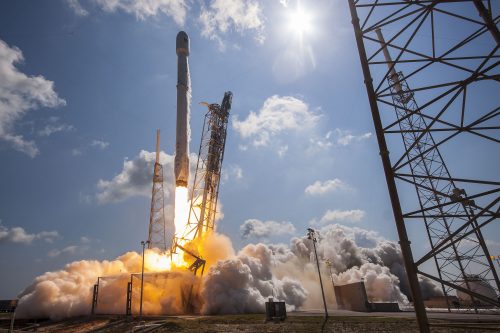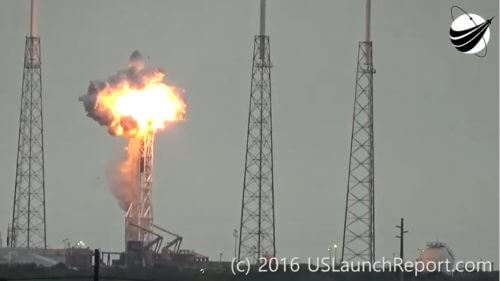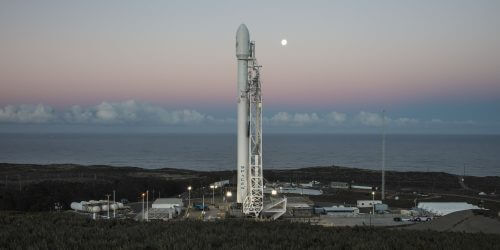SpaceX successfully returned to operations today, after more than four months in which it did not perform a single launch, following the explosion of the company's Falcon 9 launcher and the destruction of the Amos 6 satellite on top of it. In the launch, which was made possible after a complicated investigation of the accident, SpaceX launched ten communication satellites and also managed to safely land the first stage of the launcher.

SpaceX is back in business today, and in a big way. The launch was conducted from Vandenberg Air Force Base in California, at 09:58 (local time). The company's Falcon 9 launcher carried 10 communication satellites from the Iridium company, which provides global communication services.
This is the first SpaceX launch since then The explosion of the Falcon 9 launcher on September 1, during a static test before the launch of the Israeli communication satellite Amos 6, in an accident that led to the destruction of the launcher and the satellite mounted on it.
The company also managed to safely land the first stage of the launcher, on a mobile offshore rig in the Pacific Ocean. Unlike previous times when the live broadcast from cameras installed on the first stage failed to work during the reentry into the atmosphere, this time the entire reentry and landing on the rig was broadcast live in spectacularly beautiful photography.
This is the seventh time that SpaceX manages to safely land the first stage of the Falcon 9, with the first time Done in December 2015. However, so far none of the returned first stages have been reused.
Watch the landing on the offshore rig:
https://www.youtube.com/watch?v=PZ0EmJ9DlQk
After the accident last September, SpaceX's planned launches were suspended and an investigation began, led by the company in cooperation with the Federal Aviation Authority of the United States (FAA), NASA and other entities, in the end of which the cause of the explosion was identified as a failure in the helium tank that is responsible for maintaining the pressure inside the liquid oxygen tank in the upper stage of the launcher.
CEO and founder of SpaceX, Elon Musk, defined the source of the problem as "the most complicated and complex failure in the history of the company".
At the end of the investigation, Spice X published Message It reads: "The accident investigation team worked systematically through a comprehensive failure tree analysis and came to the conclusion that one of the three composite overwrapped pressure vessels (COPVs) inside the liquid oxygen tank in the second stage failed. Specifically, the investigation team concluded that the failure was most likely caused by the accumulation of oxygen between the helium tank and the padding [of the composite carbon material] in the space or in the bumps on top of the tank, which led to ignition and subsequently to the failure of the COPV tank."

"Each stage of the Falcon 9 launcher uses the COPV tanks to contain cold helium that can be used to maintain the pressure in the tank, and each COPV tank consists of an inner layer of aluminum and carbon padding. The COPV containers found after the explosion showed bumps in the aluminum layer. Although the bumps did not show the ability to rupture the COPV tanks themselves, the researchers concluded that the supercooled liquid oxygen could collect in these bumps under the padding. When compressed, oxygen that collects in the bulge is trapped there; In turn, fibers separating from the carbon composite liner or friction can ignite the oxygen within the liner, causing the COPV tank to fail. In addition, the researchers determined that the loading temperature of the helium was cold enough to form solid oxygen, which exacerbates the possibility of oxygen being trapped as well as the likelihood of ignition due to friction."
Following the investigation and in order to get permission from the FAA to return to operations, the company said that, among other things, it would change the loading temperature of the helium to a warmer temperature. In the long term, SpaceX said it will work on redesigning the helium tanks to prevent such a malfunction from happening again.

Today's launch was originally planned to take place already on January 8, but was postponed due to weather conditions.
The Falcon 9 launcher that was launched today carried 10 communication satellites of the Iridium communication company. The satellites, each weighing 860 km, were launched into a low earth orbit of about 780 km.
This is the first launch of 7 planned to be carried out by SpaceX for the Iridium company, with each of them launching 10 additional communication satellites. All in all, until 2018 SpaceX Plans Launch 70 satellites for Iridium, which will replace the company's current and aging global network, which was launched in the late 90s.

3 תגובות
Unlike the satellites launched in the statement you wrote
A question to Elisef Kusman at what height is the International Space Station